So I hope you enjoyed last week`s little glimpse into how these newsletters are constructed? It was fun for me to do it that way, and who knows, it may [need to] be repeated in the future.
My camping trip seems ages ago, but I feel a lot better now. Still have a few things to sort out internally but such are progressing, with outside assistance, and also some very good friends who are steering me back to normality, or what passes for it.
So this week we have a complete newsletter that may be devoured in one sitting or savoured slowly through the week. Enjoy, and remember if you have any comments or additional information we would much appreciate you sharing.
Lets start with a bang.
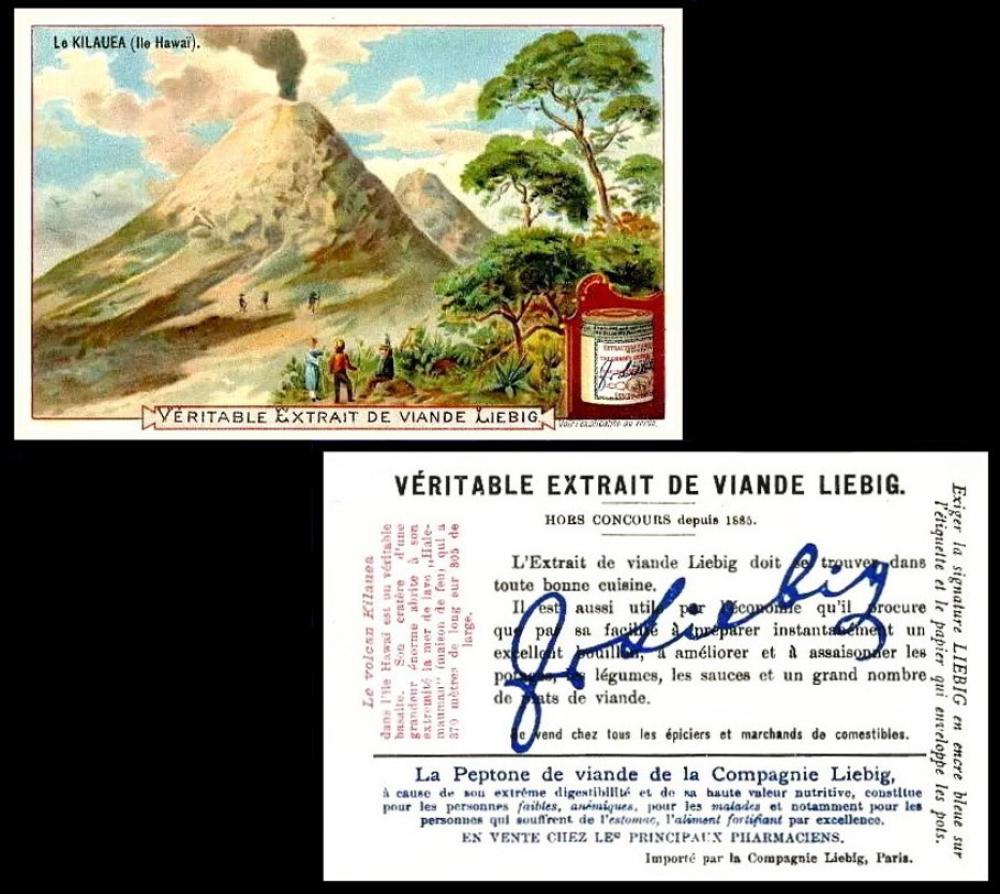
Liebig [trade : meat extract : O/S : France/Italy] "Volcanoes" (1900) Un/6 - S.653
...and also a Centenary card, for it was today in 1924 that Kilauea volcano in Hawaii erupted, and here it is on a card, issued by Liebig. Or, rather, here is the volcano, during an earlier eruption than that which we feature, for this card was issued in 1900.
You may be interested to know that Kilauea is still classed as one of the most active volcanoes too, sending forth its fiery flames every two or three years - and its last eruption was on the 16th of September 2023. Its native name actually means "much spreading", and we know it has been erupting for almost three thousand years. The length of time under fire can be considerable too, the eruption in 1410 lasting for sixty years.
Volcanoes are fascinating, but they do not appear on many cards. There is one as part of Ogdens Ltd`s "Marvels of Motion" (1928 - 23/25), this being on Tenerife. Another, Vesuvius, appears on Churchman`s "Howlers" (1936 - small sized card 16/40 and large sized card 10/16. Whilst John Player`s more modern set of "Exploration of Space", issued with `Tom Thumb` Cigars, in 1985, shows a volcano in outer space, on Io, a satellite of Jupiter (card 27/32).
Maybe you know more though?
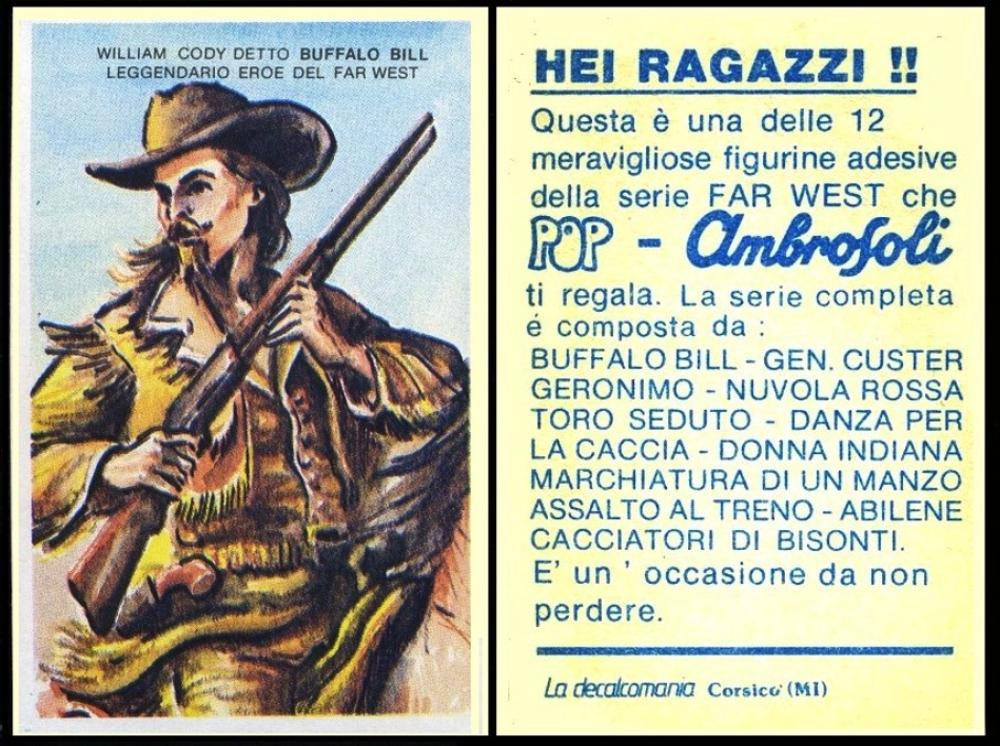
Ambrosoli [trade : sweets : O/S : Italy] "Far West" (1960?) Un/12
Here we have "Buffalo Bill”, who opened the first of his Wild West shows on May 19, 1883, at Omaha, Nebraska.
William Frederick Cody, aka "Buffalo Bill", was born in February 1845 in Iowa. His father died in 1856, and William sought employment, a series of jobs coming and going before he joined the Pony Express as a delivery boy. He was fifteen years old. The rigours of finding the isolated properties and fighting the weather served him well and he became a civilian scout in the American Civil War on the Union side, continuing in a similar role right through the Indian Wars.
He had run smaller scale shows before, starting in the 1870s, combining elements of fancy gun play, stampeding horses, run-away stagecoaches, and mock attacks by "real Indians". Most of it was total fiction, but it excited the audiences, and made him money. He also employed several of the people from the Old West, those who survived, for those were harsh times.
The shows lasted for about thirty years, and in their heyday employed about five hundred people. We do not know if it would have continued if the First World War had not come along to decimate their audience and cast, though there were already signs that people preferred the movies. In any event, William Cody died on January 10, 1917.
The most sought after cards of him are by Ogdens, and were issued with Guinea Gold Cigarettes. On one, "New Series 1", card 89, he appears as "Colonel Cody (Buffalo Bill)", on the other just as "Colonel Cody". Some of the magic is undoubtedly because the photos were taken here, during the time, around the turn of the 1900s, that he brought the Wild West to the British Isles. His French tours are immortalised by Felix Potin in their second series, issued slightly later, and the card shows him on horseback. Another must have is earlier, but in colour, and that was issued by Goodwin & Co in 1888 with "Old Judge and Gypsy Queen Cigarettes".
This set is quite an unusual one outside of Europe, but Ambrosoli are still going strong and still using the same rounded name logo. Their sweets are made primarily with honey, though they offer gummies and fruit sweets too.
The company was started by Mr. Giovanni Battista Ambrosoli, who was born in 1882 by Lake Como. He trained to be a chemist, in Switzerland, and returned to his homeland in 1906 after the death of his grandfather, taking over the family farm. He then started beekeeping, though there is a discrepancy as to whether the hives were in disrepair and he mended them, or he started the idea all on his own. He seemed to have a knack for making the bees happy, and he was inundated with honey, so he started to jar it up and sell it. He started a company selling honey in 1923, and branched out in the 1930s to make honey sweets too. He also had a sideline of floor and furniture polish, which, at that time, was primarily beeswax based.
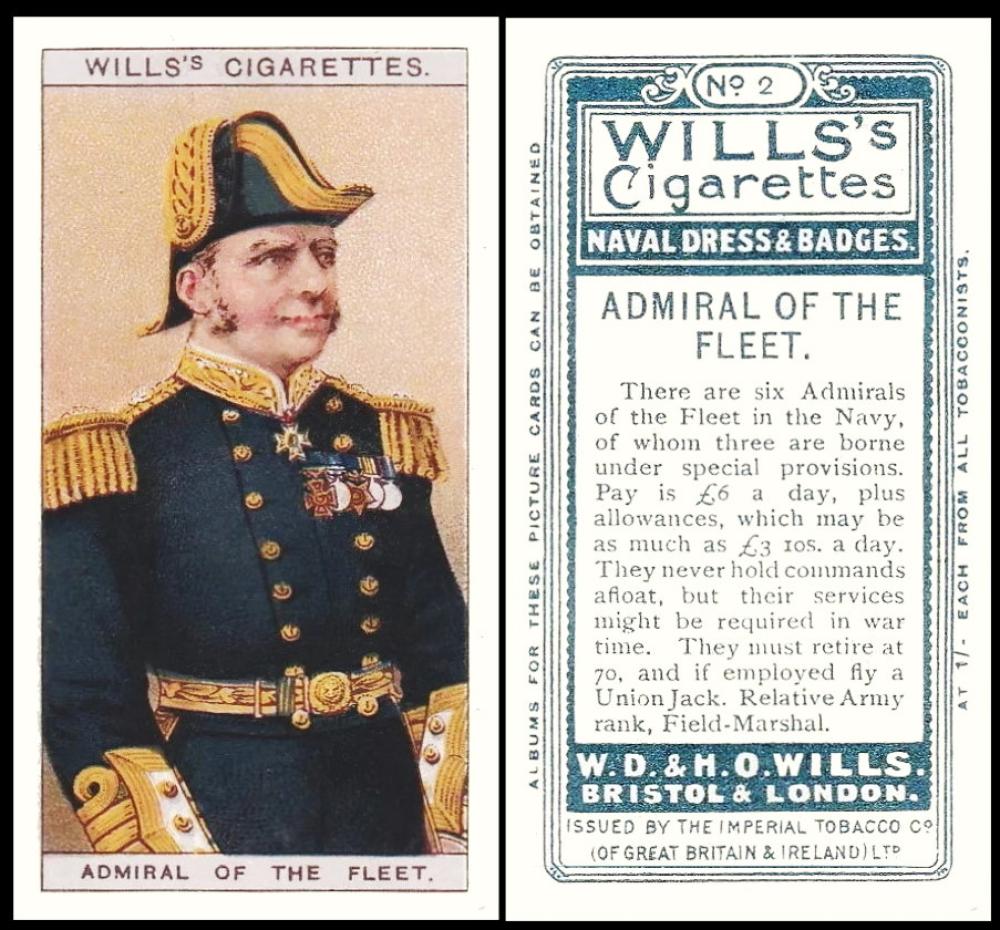
W.D. & H.O. Wills [tobacco : UK - Bristol] "Naval Dress & Badges" (July 1909) 2/50 - W675-129 : W62-91 : W/84 : H.172.
Today we have a little spot of humour, not that this man on our card would have probably thought so, but it tickled me.
What happened was that George VI was down in Spithead for the Coronation Fleet Review, today, in 1937, and, as befitting such a momentous occasion, it was being broadcast live on the radio. The man entrusted to deliver the commentary was Lt-Commander Thomas Borries Ralph Woodrooffe, who had been born in South Africa and joined the Royal Navy in 1917. He had retired in 1933 and become a commentator for BBC Radio.
Now he was a popular man with his troops, and it was obvious that they were pleased to see him, so he had been rather too well supplied with congratulatory drinks throughout the day, and was rather out of sorts, without knowing it, when the broadcast started. The man in charge coped with it for just four minutes, then our man was quietly turned off at the other end, though he almost certainly kept going on the scene a great deal longer.
When he awoke the next morning he found he had been suspended, for a week. However he did get his job back, and would not so long after be entrusted with the opening ceremony of the 1936 Summer Olympics.
And his frequent usage of the term "The Fleet`s Lit Up" was immortalised in the title of a 1938 musical comedy review.
Now by some happy stroke of luck, his recording of the Fleet Review was preserved, and you can hear it for yourself at the BBC Archives/Woodroofe
Here we have the Admiral of the Fleet, with his medals on his chest, the first of which is the Victoria Cross. The text tells us that their “pay is £6 a day, plus allowances, which may be as much as £3 10s a day.” Strangely, “they never hold commands afloat, but their services might be required in wartime. They must retire at 70, and if employed fly a Union Jack.”
This set was also issued by others, and they are discussed with the Franklyn Davey version that appears as our Card of the Day for the 25th of September 2025.
This Wills version first appears in our original Wills reference book part III as :
50. NAVAL DRESS & BADGES. Fronts lithographed in colour; backs in grey with descriptive text. Home issue 1909. Error and corrected cards of Nos. 28 and 29 are found as follows :-
(a) Gold braid on cap
(b) Gold braid overprinted in black
(c) Redrawn. No gold braid on cap.
Similar series issued by Franklyn Davey and Smith.
The other series are detailed in the Handbook as H.172. Franklyn Davey issued theirs in November 1916, and F. & J. Smith actually issued it in two formats, without an I.T.C. Clause but with descriptive text in October 1911, and with an I.T.C. Clause but without descriptive text in November 1914.
Our original World Tobacco Issues Index lists the set as simply :
NAVAL DRESS & BADGES. Sm. Nd. (50). See W/84 and H.172. … W62-91
However there is something very interesting in our updated version, for that text reads :
NAVAL DRESS & BADGES. Sm. Nd. (50). Cards from an unissued version of this set are known, with different numbers and texts and many redrawn pictures. See W/84 and H.172. … W675-129
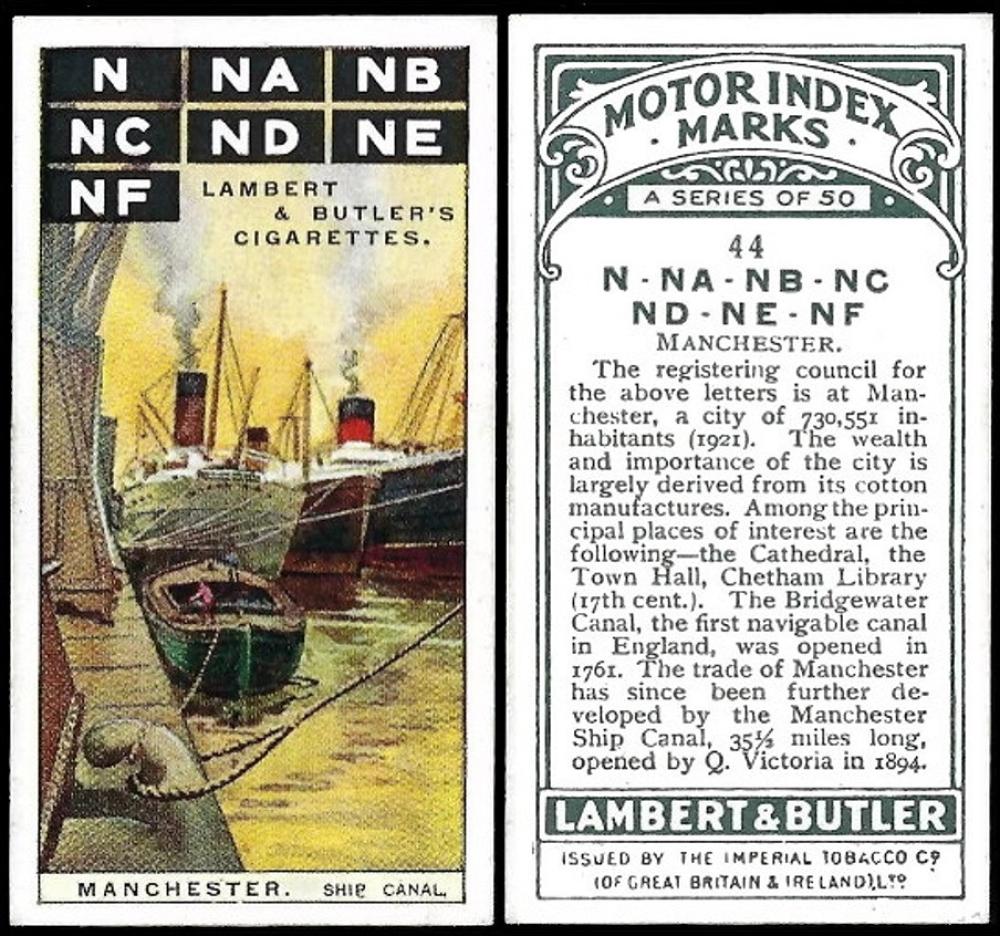
Lambert & Butler [tobacco : London] “Motor Index Marks” (December 1926) 44/50 – L073-510 : L8-63 : L/75 [RB.9/75]
Our card tells us that “The Bridgewater Canal, the first navigable canal in England, was opened in 1761. The trade of Manchester has since been further developed by the Manchester Ship Canal, 35 ½ miles long, opened by Queen Victoria in 1894". And that official opening took place today in 1894.
It is still in use today, but only by river tours and smaller cargo ships; in the 1970s the growth of containerisation meant that most commercial ships were too large to fit through it.
I have to say this is one of my favourite sets, the pictures are great and it would have been so exciting for the original owners to use the cards to spot where strange cars have come from.
It is first described in our original Lambert & Butler reference book RB.9, issued in 1948, as :
75. MOTOR INDEX MARKS. Fronts printed by letterpress, 4-colour half-tone process. Backs in dark green, with descriptions. December 1926.
This is considerably shortened in our World Tobacco Issues Indexes, to :
MOTOR INDEX MARKS. Sm. Nd. (50).
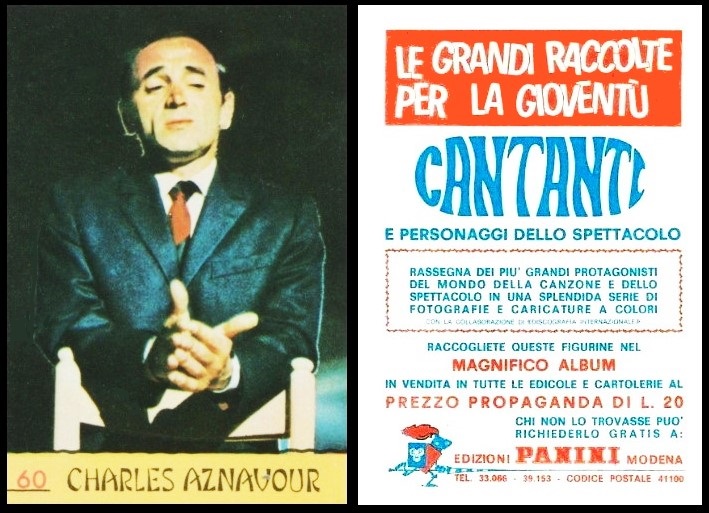
Edizioni Panini [trade : stickers : O/S : Italy] “Cantanti” (Singers) (1968) 60/299
This is quite a scarce set, which is a shame as there is much to enjoy within it. And it also contains several “rookie cards”. In addition there are three different backs, ours, which is the standard issue, plus another one, similar, but dark blue, and one for "bisvalidia"
Most of the stars are European, and unfamiliar to all but the biggest music buff, but there also are cards of Wilson Pickett, Al Bano, Bobbie Gentry, Louis Armstrong, Sandie Shaw, Marianne Faithfull, Joan Baez, Donovan, Sonny and Cher, The Jimi Hendrix Experience, The Doors, and Frank Sinatra and Nancy Sinatra on separate cards. And that`s just my choice - you can see everyone at David Halpern`s wonderful site, hosted by ImageEvent website
Here we have a Centenary card, for Charles Asnavour was born today in 1924. He is not so well known today, which is a shame, because he was multi-talented, composing music and lyrics and also singing them, recording over 1,200 songs in nine different languages. He was born in France, but of Armenian parentage, and his life, full of humanitarian efforts and kindnesses, is far too incredible for me to render it in but a few words; better that you read it all, for yourself, at Wikipedia/Charles Asnavour.
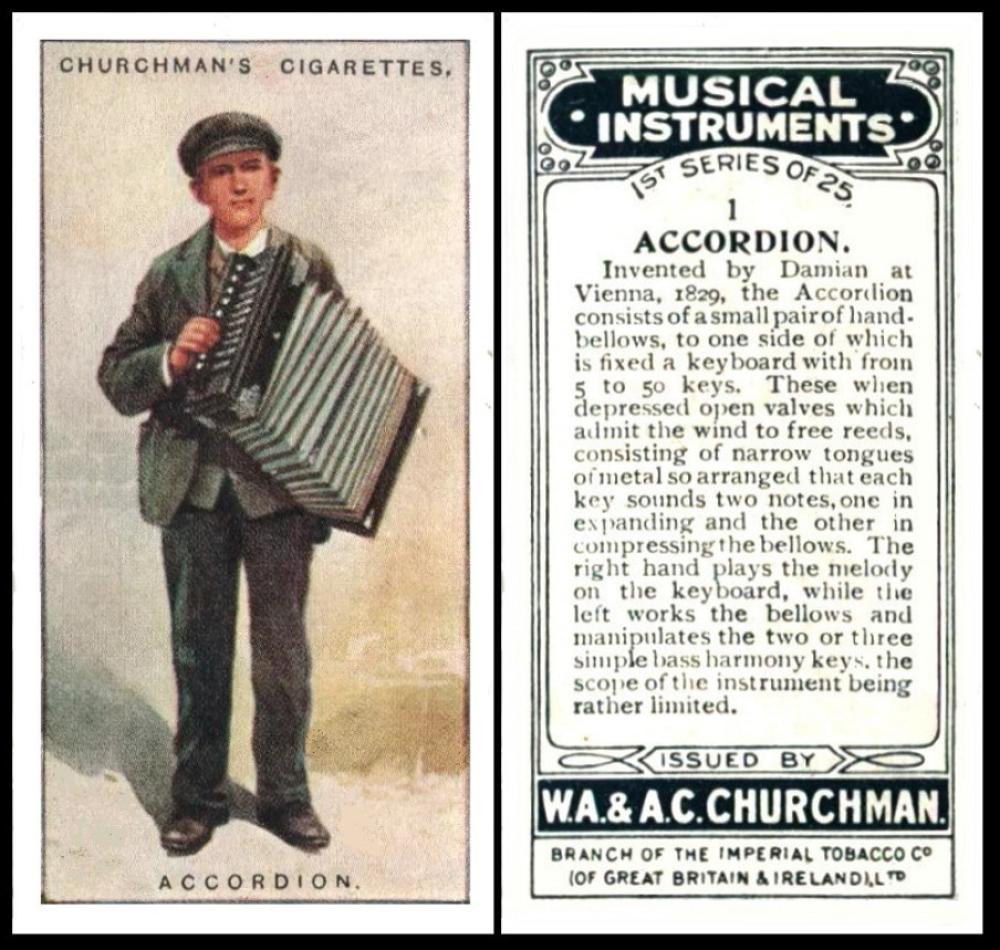
W.A. & A.C. Churchman [tobacco : UK – Ipswich] “Musical Instruments” first series (July 1924) 1/25 – C504-595 : C82-68 : C.101 : Ha.547
This card leads with the fact that the accordion was “invented by Damian at Vienna, 1829”. In fact it was patented today, and the given inventor`s name is also slightly wrong, it was Cyrill Demian, and he was Armenian. He was probably not the inventor either, because it is thought that it was invented in 1822, in Berlin, and quickly turned up in Russia.
The name simply means "concord of sounds", and the box contains a bellows, so that when the air comes in and out it makes the reed inside vibrate into music., whilst the buttons act like the strings of a guitar and change the pitch.
This is a lovely set, but don't go hunting for series two because there never was one. We do not know why either.
The set first appears in our original Churchman reference book RB.10, issued in 1948, as :
101. July 1924. 25. MUSICAL INSTRUMENTS (titled series). Size 2 11/16” x 1 7/16” or 67 x 36 m/m. Numbered 1-25. Fronts printed by letterpress 4-colour half-tone process. Backs in dark green, with descriptions. Printed by Mardon, Son & Hall.
Also issued by Edwards, Ringer & Bigg and Lambert & Butler.
This turns out not to be entirely true, for the set was not issued by Lambert and Butler, though it was issued by Edwards, Ringer & Bigg, and actually before the Churchman version, in January 1924.
In our World Tobacco Issues Index the set is listed as :
MUSICAL INSTRUMENTS. Sm. Nd. (25). See Ha.547. … C82-68
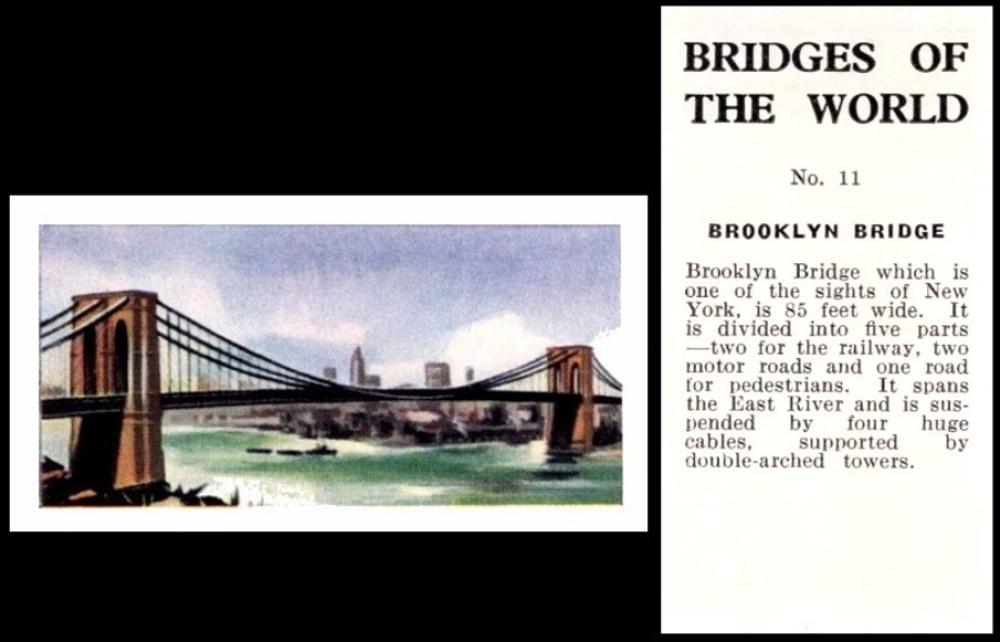
Anonymous [trade : UK] “Bridges of the World” (1958) 11/25 – ZAB-050 : HX-132 : ZB9-3 : D.226
Lets close here, with a trip to New York. Now if you had been there today, in 1883, you would have been just in time to watch the opening ceremony. However it was not the Brooklyn Bridge then, it only became that in 1915. Until then it was known as either the New York and Brooklyn Bridge, or simply the East River Bridge, because it was the first fixed crossing of that mighty river that had ever been accomplished, and it was huge, just over 1500 feet long, and almost 130 feet above the water at high tide.
Our card is anonymous. However it has plenty of facts, telling us that it is “85 feet wide…divided into five parts, two for the railway, two [for] motors and one for pedestrians. It spans the East River and is suspended by four huge cables, supported by double arched towers.
This set first appears in our British Trade Index part II at the back of the book under anonymous issues, without reference to commodity or periodical. The listing is :
BRIDGES OF THE WORLD. Sm. 67 x 35. Nd. (25) See D.226.
Now D.226 is that magical place where other issuers of the same set are stored, sometimes one, sometimes more. The text for this set reads :
D.226. BRIDGES OF THE WORLD. Nd. (25)
A.S. Prior –Set PTO-1
Anonymous, Letterpress Back – Set ZB9-3
Now A.S. Prior was a fish and chip retailer, in Battersea, London. They issued four sets, our Bridges, “Cacti” in both a numbered and an unnumbered version, “Evolution of the Royal Navy” and “Flags and Emblems”
This week's Cards of the Day...
... celebrated the first ever Academy Awards, or "Oscars", which took place on May 16th, 1929. And even if you are not a movie lover I am sure you will enjoy this theme, as well as find out some fun facts with which to amuse your friends and neighbours !
Now there are many different stories about why we call them "Oscars" but only one as to why they are called the Academy Awards - that being because they are presented by the Academy of Motion Picture Arts and Sciences - and, in the inaugural year, the President of the Academy, Douglas Fairbanks (Senior) was the host of the event. That was a little different to how they are presented today, for it was simply a dinner to honour some of the best films between August 1st, 1927 and July 31st, 1928. The dinner lasted just fifteen minutes, (and tickets cost five dollars), for there were only twelve awards - four of which were only presented that once, these being Best Director specifically for a Comedy Film, Best Titles (sub-titles, because many films were still silent), Engineering Effects (forerunner of today`s Special Effects), and Unique/Artistic Production.
Amazingly it none of it was broadcast over the radio, and television was in its infancy, only having been first successfully demonstrated in San Francisco on September the 7th, 1927. That means that the second Academy Awards were actually the first to appear on the radio. And it was not broadcast on television right until 1953.
so firstly, on Saturday, May 11th, we brought you :
Saturday, 11th May 2024
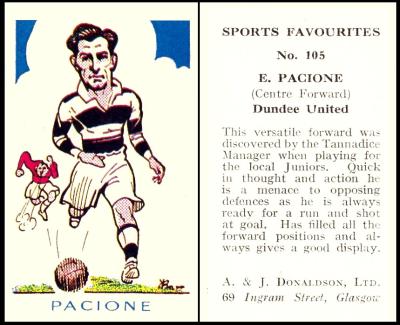
easy enough to identify as a card, but rather hard as a theme-giver. The clue was nothing to do with the player, or the issuer, it referred to the team, Dundee United, because one of their players is still the only professional footballer to win an Academy Award.
His name was Neil Paterson, and he was born just as 1914 became 1915, in Greenock. He played for the very romantic sounding name of Buckie Thistle FC (unless you sit on it, not so romantic then!), in the Highlands, and then for Leith Athletic in Edinburgh. In 1936 he joined Dundee United, and even became their captain, but he had a yen to write and found a place as a sports writer with a company we all know well, that being D.C. Thomson. The Second World War found him in the Navy, passing the time by writing fiction. Some of this was published in the post war years and was quite popular; one of his short stories, "The Kidnappers" was even made into a film, which was released in 1953, and he also wrote the screenplay, something he must have enjoyed because he wrote others, for other peoples` books, including John Braine`s "Room At The Top", which won him the Academy Award for Best Adapted Screenplay.
Unfortunately I have not tracked him down on a card, so for the time being this one, celebrating the team alone, must suffice. But maybe there is a card of Mr. Paterson, out there, somewhere that I do not know, with which I might replace it.
Our man was actually christened Emilio Pacione and he was born on March 20th, 1920. He played for Dundee United between 1945 and 1950 as either a centre forward or a right winger, but there must be some Irish heritage in him because he also played for Lochee Harp Juniors and Coleraine. However it looks like this was his only cartophilic appearance, unless you know otherwise?
He died on the 25th of August 2012.
This a rather confusing set, because it contains many different sports. It is described in our original British Trade Index Part II as :
SPORTS FAVOURITES. Sm. 63-66 x 38-40. Footballers, Boxers, Golfers, Speedway Riders, etc
White borders, back in (a) black (b) blue. Following are lowest and highest numbers known in each group of subjects.
1-247 (Footballers), 250-297 (Boxers), 300-301 (Billiards), 306-317 (Athletes), 323-330 (Golfers), 350-356 (Boxers), 360-397 (Footballers), 400-445 (Speedway Riders), 455-460 (Footballers), 58 (479) to 64 (485) (Speedway Riders).
Several numbers with two different portraits of same player.Yellow borders, back in blue, inscribed "Golden Series" (? 20)
The heading tells us that the cards were issued 1948-50, and this is the only set listed.
By our updated British Trade Index, though, more sets have appeared and the dates of issue now start at 1946, and end at 1955. The listing of this set in there is :
SPORTS FAVOURITES. 63-66 x 38-40. Commercial issue, in booklets.
White borders. Nd. (534 highest seen). Backs in (a) black (b) blue. Issued in batches, covering different sports, see details at HD-48.
1950. Yellow borders, blue back,, inscribed "Golden Series". Nd. (64). All footballers.
1953. Oldham Athletic. Unnd. (12). Issued to celebrate Oldham winning promotion in 1953. See HD-58.
Sunday, 12th May 2024
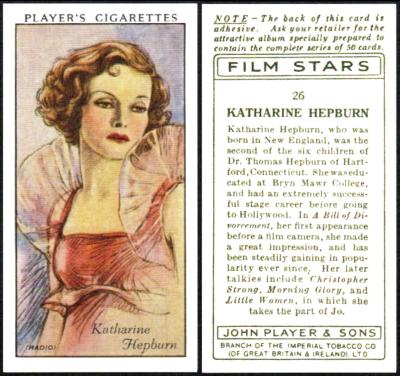
Card Two showed the lovely Katherine Hepburn. She was not the first actress to win an Academy Award, but she did win four, all for Best Actress, which is the most ever awarded to one person. She was also nominated twelve times in total, a number only just beaten by Meryl Streep. If that were not enough she has the longest award winning career of any star, for she won her first Academy Award in 1934 for "Morning Glory" and her last in 1982 for "On Golden Pond". And she also was one of the few people to come joint first place, in 1969, when she tied with Barbra Streisand. This in itself was a rarity as only six ties have ever occurred in the entire story of the Academy Awards - which you can read about at FarOut/Ties
By the way, the first ever actress to win an Academy Award was Janet Gaynor. She won for a body of work, three films, "Seventh Heaven", "Street Angel", and "Sunrise".
Now though there were three series of Film Stars issued by John Player this set was never called the “First Series”, or even “A” series – the top wording on the back simply says it is a “complete series of 50 cards.” It had adhesive backs, ready to be stuck in the special album, and it was not issued overseas. The second 50 subjects said “Second Series” and were also issued in Ireland, omitting the cost of the album; whilst the “Third Series” was also issued in the Channel Islands and in Ireland, where the cards were re-printed and specially entitled “Screen Celebrities”.
Our original John Player reference book and all our World Tobacco Issues Indexes group the three series together under “Film Stars. Sm. Nd.”.
That original John Player reference book catalogues our set as :
FILM STARS OR SCREEN CELEBRITIES. Small cards. Fronts in colour. Backs in grey, with descriptive text. Special albums issued.
90. 50. First 50 Subjects. Film Stars. Adhesive backs. Inscribed (in album clause) “Series of 50 cards”. Home issue, March, 1934”
In the World Tobacco Issues Indexes the text reads :
1. First 50 subjects. Home issue, inscribed “…series of 50 cards” in album wording
Strangely this set does not seem to have been issued in Ireland, unless, of course, it was done so with no change to the wording. However the second and third series were both issued in Ireland, the second having the album clause slightly altered to remove the wording “price one penny”, and the third being much altered, even being renamed “Screen Celebrities”.
Monday, 13th May 2024
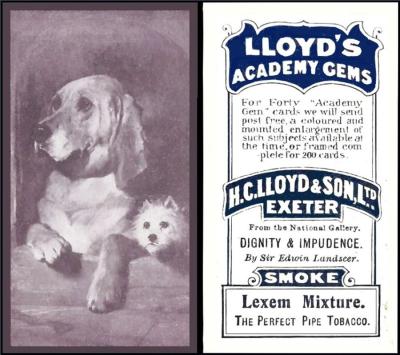
Finally we showed you this card, of an 1839 painting called “Dignity and Impudence”, by Sir Edwin Landseer. This card may be in monotone, but the original is in colour, and currently hangs in the Tate Gallery.
The back was the link to our theme though, as that reveals that it is one of the “Academy Gems”, hence giving us another link to the “Academy” Awards – and maybe also the gems hearken to the jewels that are glisteningly sported by the attendees?
This Academy is not the same though, it is the Royal Academy of Arts, and artists who are members thereof are allowed to use the suffix of RA after their name. Our artist, Edwin Landseer was elected on the 10th of February 1831, but was not the only member of the Landseer family to be so, his father John, and brothers Charles and Thomas also were. But Edwin was the only one who was elected President of the whole Academy, in 1866, though, sadly, he had to turn it down, feeling he was not in good enough health to do the position justice.
This set was designed to be swapped for a print, or print(s) if you were a very keen smoker, for, in exchange for forty cards, you would receive “a coloured and mounted enlargement of such subjects available at the time, or framed complete for 200 cards”.
The story of H.C. Lloyd & Son., Ltd., is rather confusing, despite it being the largest employer in Exeter, and also many of those people were female, for their hands were smaller and more careful when it came to coaxing the leaves to roll up and form the future smokes.
Their premises were in Fore Street, but they had been linked to that street for many years before they ever came to sell tobacco. The earliest link so far traced is Robert Cross, who came to Exeter from Bristol, and founded the General Bank, in Fore Street, in 1792. By that time his son, Henry Cross, was aged sixteen.
At the turn of the nineteenth century, the son Henry Cross was listed on a court document as being a tobacconist; snuff maker, and tea blender. Sadly this was concerning the failure of his business and his bankruptcy. A few years later he returns to tobacco, but not for smoking, instead as an aid for farmers to remove mites and insects from their sheep and other livestock. It seems likely that he was also offering smoking tobacco on the side to those same farmers, perhaps as samples, as the next year he started advertising that he was now blending his own smoking mixtures. This was about the same time that his son, confusingly also named Henry, was born.
Now in 1843 Richard Lloyd of London bought them out, and the grandson of the founder of the London business, Richard Lloyd, moved in to the Exeter address.
This is probably where some of the confusion comes from, and it is made even worse by the fact that in June 1886, the Exeter company was taken over by Richard Lloyd`s son, who was called Horace Charles Lloyd and it was renamed H C Lloyd and Son. However, actually Richard Lloyd had two sons, Robert Lloyd and Horace Charles, and they assumed control of the Exeter branch in 1886. Many people think that Horace Charles was the main spur behind this and that is how he got his initials on the company, but he died shortly after taking over, so it could have been a tribute, or a way of remembering him, as his own son was too unwell to work in the trade. Robert Lloyd was a canny businessman and he extended the premises by buying a neighbouring shop when it closed down. He also immediately saw that the shape this created would allow for greater mechanisation of the processes,and somehow managed to install a machine which boasted of making almost five hundred cigarettes a minute.
Despite this, the company did not begin to issue cards until 1899 - and it looks like they only started branding their tobacco in 1897, "Honeydew", "Merrimac", and Ripley" all appearing in that year. However, our "Directory of British Cigarette Card Issuers" (RB.7, published in 1946) has their entry as : "76/77 Fore Street Exeter. Founded 1785. (This was originally a branch of the London business of Lloyd. Exeter opened 1845 - separate business from 1866. Afterwards H.C. Lloyd & Son (1925) Ltd. Trade-mark : Elephant and Castle. Now make cut tobacco only. [Brands] "Typsy Loo", "Yacht Club", "Exeter".
During the Boer War, and during the First World War, they regularly supplied the local regiment with tobacco and smokes, and the same was true of the first World War. However, despite the friendship and regard with which they were held in the local area, in peace time they struggled. In 1921 they went into liquidation - and three years later the assets and goodwill were acquired by Cope Bros.
Then, in 1921 this business went into voluntary liquidation and the stock and premises were auctioned. In 1924 . A few years later, somehow, Cope Brothers came along and bought up the stock and some of the plant which had failed to sell, and it appears that it is they who operated H.C. Lloyd & Son (1925) Ltd.
This set turns out to have many variants too, and is catalogued in our original World Tobacco Issues Index as :
ACADEMY GEMS. Sm. 67 x 36. Front in (a) reddish-brown (b) dark purple (c) green. Unnd.(28). See X1/H.258. Multi backed … L54-1
A. “Broadare Finest Virginia Returns.”
B. “Cherry Ripe Fine Aromatic Honeydew”
C. “Farmville Finest Golden Virginia”
D. “Gold Royal Gold Flake Cigarettes”
E. “Gold Royal Sun-Cured Tobacco”
F. “Lexem Mixture” [the perfect pipe tobacco]
G. “Lloyds Exeter Topsham Mixture”
H. “Old Adjutant Flake”
We also know that Lloyds produced “Tipsy Loo” cigarettes, and that “Lloyds Exeter” was not just a pipe mixture, it was available as cigarettes too. In fact it looks like brand G above is two brands, "Lloyds Exeter" and "Topsham Mixture", perhaps gently separated by a very faint comma or dash. Both these brands are also found on other sets of cards - “Tipsy Loo” on “Star Girls” and “Exeter Cigarettes” on “Actresses and Boer War Celebrities” and “Devon Footballers and Boer War Celebrities”. So it seems odd that neither of these brands have so far been discovered on our set – unless you have them in your collection….?
The link to X1/H.258 sends you to the handbook to the original World Tobacco Issues Index, where there is a table of cards and backs found so far.
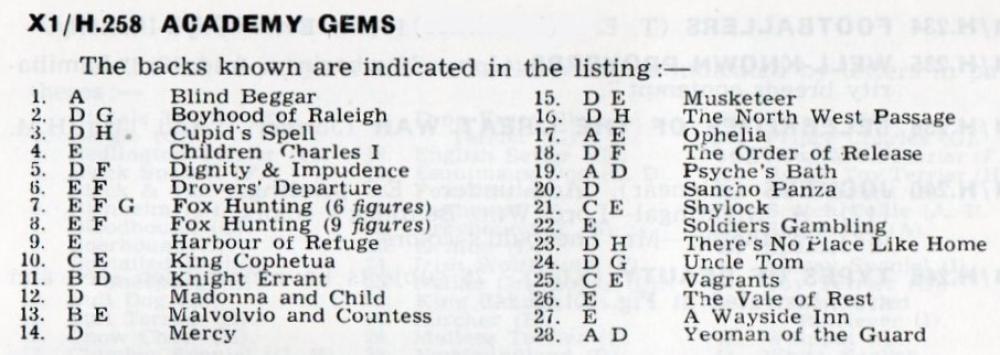
This table is slightly altered in our updated World Tobacco Issues Index, and it gives the entire title of the artwork, plus the artist, so we may as well include that too. Also, some of the brands that have been noted for each card do seem to differ, so maybe you could have a check through your cards and do a spot of confirm or deny.... with many thanks
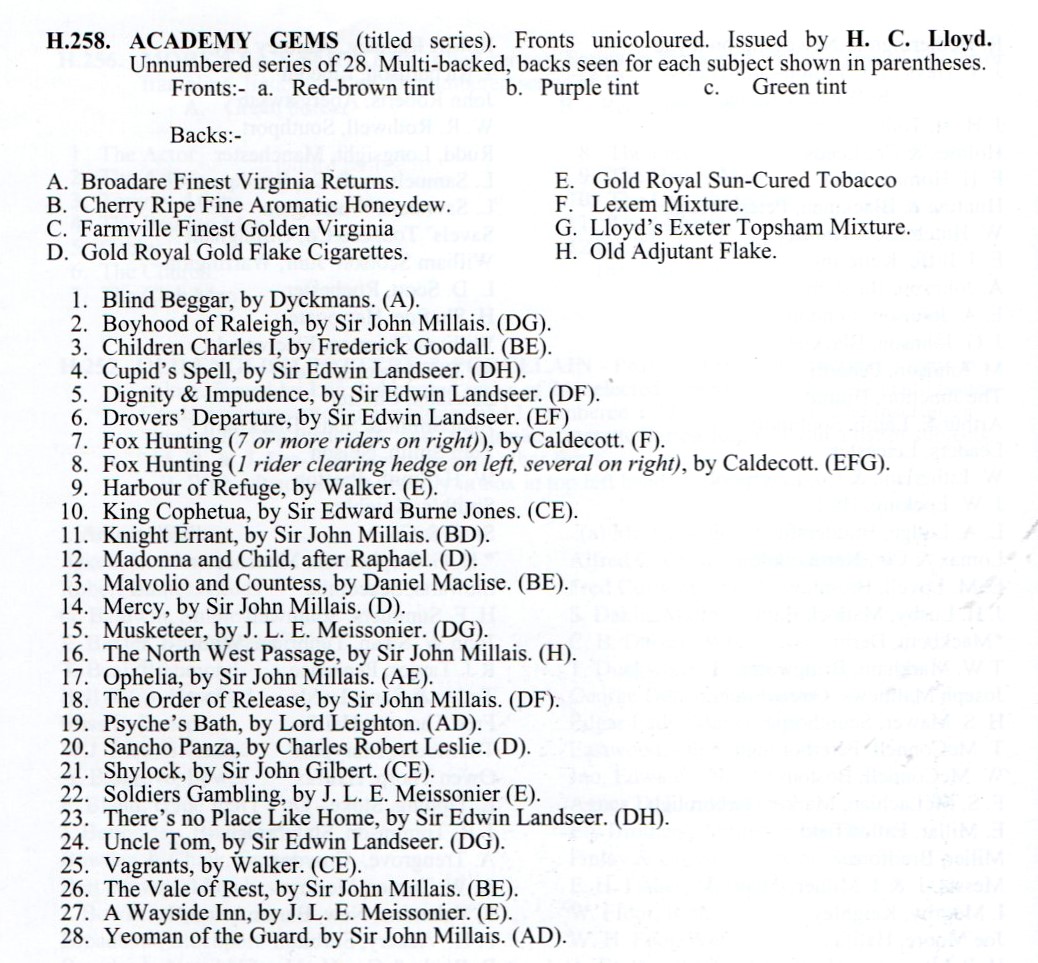
Tuesday, 14th May 2024
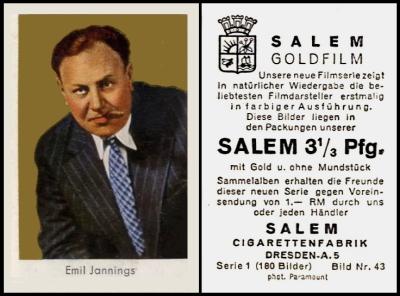
Here we have Emil Jannings, who was not only the first recipient of the Best Actor category, but the first to ever receive a statuette, because it was presented to him in advance of the ceremony, before he left America, where he had been staying, for his homeland.
He was born in Switzerland to a German mother and an American father, and christened Theodor Friedrich Emil Janenz, but he regarded himself as a German actor. As such, he is the only German ever to win the Best Actor category. His win was for two roles, "The Way of All Flesh" (1927) and "The Last Command" (1928).
He died in 1950, aged sixty-five.
This set is called "Goldfilm" because of the gold square that forms the backdrop to the film star`s head. It first appears in our original World Tobacco Issues Index as : -
SALEM GOLDFILM (Salem Goldfilm Series) Sm. 60 x 40. See X.24/9.D ... S14-12
1. "Serie 1". Nd. 1/180
2. "Serie 2". Nd. 181/450 (270)
This is repeated in our updated version, but without the X.24 reference, because that links to the original Handbook, which was either a separate volume (for the first edition) or re-printed in the back of the original World Tobacco Issues Index.
Now the "X" numbers are in the handbook, and "X.24" is a separate section devoted to German Language Issues. The text there reads :
X24/9. GOLDFILM SERIES. Small size, 60 x 40 m/m. Coloured pictures of Film Stars with gold background. Two series :-
1. "Serie 1". Numbered 1/180
2. "Serie 2". Numbered 181/450.(a) German Language backs
A. Bulgaria. Titled "Bulgaria Goldfilm". (1) known. [Bulgaria Zigarettenfabrik, Dresden]
B. Constantin. Titled "Constantin Goldfilm". (1) and (2) known. [Constantin Zigarettenfabrik, Hannover and Dresden, but this set only issued through Dresden]
C. Delta. Titled "Deutschmeister Goldfilm". (2) known. [Zigarettenfabrik "Delta" G.m.b.H, Dresden]
D. Salem. Titled "Salem Goldfilm". (1) and (2) known. [Salem Zigarettenfabrik G.b.m.H, Dresden](b) Dutch Language backs
M. Batschari. Titled "Mercedes Goudfilm". (1) known.
I find it fascinating that all the German sets were issued out of Dresden. And it turns out that the Dutch language set also has a German connection, because M. Batschari turns out not just to be N.V.A. Batschari`s Sigarettenfabrik den Haag, Holland, but a Dutch associate of A. Batschari Cigarettenfabrik of Baden-Baden, Germany, who also used the brand "Mercedes" for their own issued "Film Photo Series". In fact, though they issued only the first series, they did so in two versions, the standard size, and as double uncut pairs, which, oddly, seem to follow no pattern as to which cards were printed together.
We now also know, thanks to several readers, that this set was issued in Germany by another issuer, Baltic, and by Fernando Fuentes in the Canary Islands, though I am not quite sure about that as these are the cards with the gold border that we featured earlier (on the 9th of February, in our newsletter 2024-02-03) and they show 1950s stars not 1930s ones. It can also be found in trade card collections, though, the easiest to acquire being a plain backed version by De Beaukaeler biscuits, but also by Avis of Egypt, Chocolat La Cigogne of France, Danmarks of Denmark (as "Guld Films Billeder"), and Ebe and Einar Ahlström of Sweden.
Wednesday, 15th May 2024
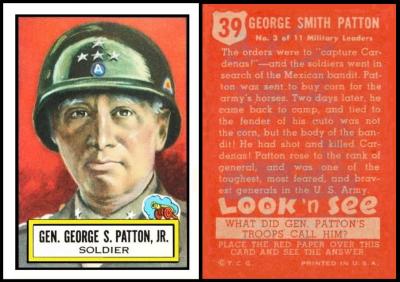
This card may have surprised a few of our readers who do not know the story of the Academy Awards, but it celebrates the first time an actor refused to accept one. That was George C. Scott, who played our man, George Smith Patton in the film of his life, called simply "Patton", released in 1970. In fact, Mr. Scott initially refused the nomination, as he had done in 1962 for "The Hustler", because he did not feel comfortable being compared to other actors. In that year he did not win so it was of no import. However in 1970 he did win, and he did not back down. The film`s producer collected the award on his behalf and it was given to the Virginia Military Institute.
Now Mr. Scott may have been the first actor to refuse, but he was not the first person to. In 1935 Mr. Dudley Nichols, the screenwriter of the film "The Informer" did, citing the preferential treatment of the Screen Playwright`s Guild over his organisation the Screen Writer`s Guild.
This set is often cited as one of the favourites of all time. Perhaps that has something to do with the stunning artwork, or maybe it is just one that most of today`s collectors remember collecting when they were children. By the way we only know the year, or rather the earliest it was issued, from card 104, which shows Queen Elizabeth II, for she was crowned in February 1952. The cards are undated.
There are a hundred and thirty five cards in the set, but it was actually issued in two parts, the first batch being numbers 1-75 and the second being the remaining sixty cards. Nobody seems to know why they did not have two groups of seventy-five, making a more even total of a hundred and fifty. There is a bit of a downer though, because it is very hard to get one that looks like ours, with almost square borders. Most of them are out of square to one side or the other, with one slim to non-existent border, and one huge one and this does affect the value, though in years to come we may find this matters less.
Before we race on, did you know that this large set is split into groups? Well have a look along the top edge of the box that holds the subject`s name and you will see a small cartoon style picture. In this case it is a cannon, for the military. The card of Billy the Kid has a covered wagon, for the Wild West, and for some reason the most sought after card of all, Babe Ruth, has a shield.
Something else you may not have noticed is that the backs actually have a drawing on them, a kind of watermark under the text. This is often very faint but on our card you can fairly clearly see it is a tank, surprisingly, as these red backs are almost impossible to scan and keep the wording legible. There was a point to them though as in each pack there was “A Decoder” and this tool was used to reveal the trivia answer on the card. It was actually just a red strip of cellophane, but it worked, in a fashion, and it certainly worked better because of its scientific/espionage related name, especially if you think of what America was like in the 1950s…One thing I would love to know is how the "red paper" decoder worked. This was a piece of red cellophane which you put on the back of the card and it magically told you the answer to the question on each card. The only slight problem is that the cards do not actually call it “A Decoder” they just say “the red paper”.
By the way the most sought after card in the set is Babe Ruth, the only baseball player and actually the only sportsman. There is a bit of a rumour that Rembrandt (number 82) is a key card, and that either he was printed separately as a very short run, or that his cards were somehow held back. I am not sure of these theories, for surely doing this to a more prominent American would have had a bigger impact. And just imagine if they had selected Babe Ruth ...
Thursday, 16th May 2024
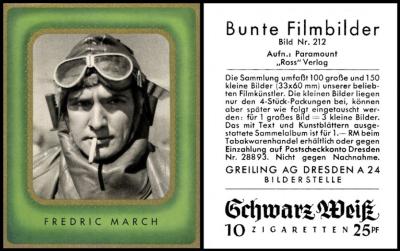
Fredric March has a huge claim to fame regarding the Academy Awards because his was the first Best Actor statuette to be awarded to a science fiction film, that being "Dr. Jekyll and Mr. Hyde". Actually it was deemed to be a tie, with Wallace Beery in "The Champ", though if we are getting technical there was one more point in it, for our man.
In actual fact, the correct title, from the book, written by Robert Louis Stevenson, in 1886, was "Strange Case of Dr. Jekyll and Mr. Hyde", and it was one of the first Gothic Horror Novels. Stevenson was fascinated by the possibilities that you could be one thing on the outside and have such dark hidden fantasies inside, and he pored for hours over lurid court cases. He also had a friend, though whether he sought him out immediately after the event, or knew him before seems cloudy; this was Eugene Chantrelle, who had killed his wife with opium in 1878, and we know that Stevenson attended the trial, where he found out, to gleefully recant later, and often, that the man had poisoned other people in the same way too, perhaps even as a test run. Another of his subjects was a man called William Brodie, who was a locksmith by day, and who made copies of the keys to ransack the homes at night. He maintained two mistresses, neither of whom knew the other, with whom he had five children. There were rumours of other women, and children, too.
I am not entirely sure that the film was science fiction, but many people put in that genre. And for those that do, this becomes the first science fiction film ever to win an Academy Award. Science fiction seems not be regarded too highly by the Academy, though they did create categories for it, later on, the Art Direction, Scene Direction, and Special Effects, to name but a few. A list of those nominees, and the few winners, appear at IMDB/SciFi.
If you discount our film as a science fiction one, though, then the first true Sci-Fi film to actually win the Best Picture statuette was "Everything Everywhere All at Once - but not until 2022...
The film on this card is not titled but it is almost certainly "The Eagle and The Hawk (1933) in which Fredric March and Cary Grant were the male leads and Carol Lombard appears briefly as the glamour/love interest.
This is a variant of a set issued by many other companies. It is branded for "Schwarz Weiss" or Black and White. It is catalogued in our original World Tobacco Issues Index as :
BUNTE FILMBILDER (Coloured Film Stars). Sm. 60 x 33 (150) and Lg. 72 x 58 (100). See X.24/2C
1. First Series. (250)
2."II Folge" , Nd. 251/500 (250).
That is the same in our updated version but the "X" reference is not there because that relates to the original World Tobacco Issues Index Handbook. The listing under X.24/2C adds quite a bit of additional info, namely :
BUNTE FILMBILDER (Coloured Film Stars). Two numbered series, each small size 60 x 33 m/m (150 subjects) and large size 72 x 58 (100 subjects). Pictures in black and white, coloured framework. gold borders.
1. First Series. Numbered 1-250
2.Inscribed "II Folge" , Numbered 251/500
A. Austria G.m.b.H. (1) and (2).
B. Brinkmann. (1) with firm`s name (2) brand issue, inscribed "Lloyd Zigaretten"
C. Greiling. (1) and (2)
D. Jasmatzi. (1) not studied (2) brand issue, inscribed "Unsere Marine"
E. Massary. (1) and (2) Brand issues, inscribed "Caid"
F. Orienta. (2) only known
G. "Polo" brand issue. (2) only known
H. Zuban (1) and (2).
And one day we will link out to cards with all these different backs!
Friday, 17th May 2024
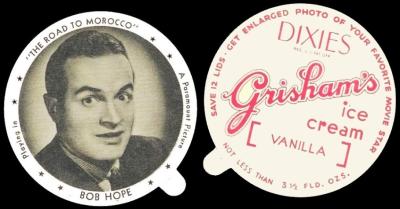
The unusual shape of this item may baffle some of you, but this is a lid from off a single serving ice cream in a tub. The creamy coloured top with the wording was on top, and when you peeled it back you revealed the picture of the star beneath.
Now I cannot find a listing of these, only odd ones scattered across the internet. The film on this one is "Road to Morocco", which was one of the famous Bob Hope and Bing Crosby`s "Road To" movies, often accompanied by Dorothy Lamour. There were seven trips in all, starting in 1940, and 1940 is often given as the date of these lids, but our film was later, being released in November 1942.
As for why we have Bob Hope, he holds the record for hosting the most Academy Awards ceremonies, nineteen in all, starting in 1940 and ending in 1978. He was never nominated for any statuettes, but he did receive honorary awards for his service to the motion picture industry, plus the Jean Hersholt Humanitarian Award in 1959
And there I must close, having run a bit over time through doing two newsletters in one week. Hope you enjoyed the chaos. Have a great week, and normal service will be resumed next week, probably.....
